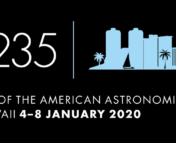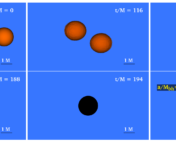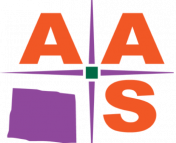In this series of posts, we sit down with a few of the keynote speakers of the 235th AAS meeting to learn more about them and their research. You can see a full schedule of their talks here, and read our other interviews here!
Seeing the Light of a LIGO Event
When two neutron stars merge, the event is so massive that it creates ripples in spacetime itself. These are called gravitational waves, which were recently detected for the first time by LIGO. For such a merger, with two leftover stellar cores spiraling into each other, we’d also expect a whole lot of light, known as a “kilonova” – a bright flash a thousand times brighter than a typical supernova. Today we’ll hear from Professor Brian Metzger, who pretty much wrote the book on kilonovae. (Really, he wrote a whole review paper about them!) He’s an Associate Professor of Physics at Columbia University, and one of this year’s Bruno Rossi Prize winners, along with Professor Dan Kasen. They are being awarded this prize for their theoretical predictions of electromagnetic emission from neutron star mergers, which were confirmed in 2017 by LIGO observations.
From a Science-Loving Town in Iowa…
Professor Metzger was practically born into an interest in physics and astronomy: many astronomers hailed from his hometown in Iowa, including Ed Stone (the PI of the Voyager missions) and Van Allen. Being an astronomer was a clear path there, so he followed that through his undergraduate education at University of Iowa, then took a “pretty traditional” path through graduate school in physics at Berkeley and an Einstein prize postdoc at Princeton before applying for his current position as a professor at Columbia. He describes himself as “a theorist interested in practically understanding and observing things” and spent most of his time as a grad student learning about a broad range of topics, “basically all besides planets.” As a grad student exploring the intersection of a few fields, he made the first quantitative prediction of a kilonova light curve, because LIGO observations were expected soon, and no one had done that calculation yet.
…To Some of the Most Explosive Events in Space

A few years later, in 2017, the first electromagnetic counterpart to a gravitational wave event (this time a neutron star merger) was observed, a lucky turn of events. LIGO and VIRGO observed the gravitational waves, and other observers jumped into action to search for the expected gamma ray burst (GRB) and optical afterglow from the kilonova. As Prof. Metzger says, it’s incredible “just how lucky we got with this first event – how quickly the neutron star merger came, how perfect the event was, that VIRGO could help with sky position [it had just come online], and that the jet of the GRB was so close to our line of sight.” His original 2010 models reproduced the observed properties of that event, and they helped find the galaxy where the merger happened. He emphasizes that “we can make predictions, but it wouldn’t be possible without all the others”, thanking all the people in the LIGO collaboration and the other observers who made this first observation possible.
Now, he’s hoping we can see more of these neutron star mergers, to answer more questions about kilonovae and how they form the heaviest elements of the universe. We know that mergers eject neutron-rich material into space, which forms heavy elements by bombarding iron with neutrons, known as the r-process. Since those new heavy nuclei are radioactive, heat from their decay produces the optical and infrared light we observe. From this event and hopefully future observations of other mergers, Prof. Metzger wants to answer big questions about neutron star mergers: How often do they happen? How important are they as a source for heavy elements on planets like Earth?
So far, we’ve only observed that one 2017 merger – but how typical was that first observation? If we have different stars merging, it seems like we should see different kilonovae —as Prof. Metzger says, “There’s not just one kilonova!” He hopes to use these events as probes of other astrophysics questions, too, such as how long the material of the merger stays around making heavy elements before it collapses into a black hole.
Finding Connections in Astronomy
As someone working at the intersection of many fields, Prof. Metzger emphasizes the importance of breadth in one’s career. He suggests setting aside half an hour in the morning to read relevant literature to help connect things, since fields are so big nowadays. For those applying to grad school, he also highly recommends talking to your undergrad advisors about where to go to grad school and who to work with. He says to “look for the best school for what you’re interested in, and who would be a good advisor, who you’d work well with,” and to rely on your current advisor to help find those people, since they likely have a network they can draw from.
Be sure to check out Professor Metzger’s HEAD Bruno Rossi prize plenary talk (with Prof. Dan Kasen) about “Kilonovae from Merging Neutron Stars” on Monday, January 6th at 4:40pm at #AAS235.




